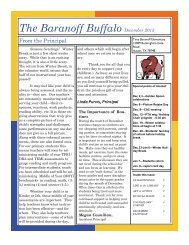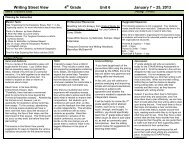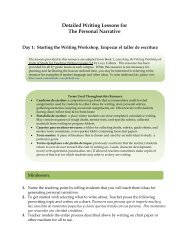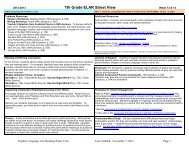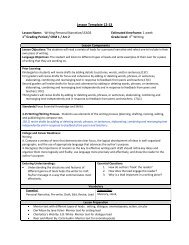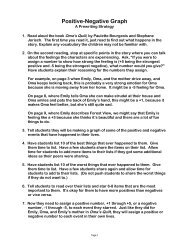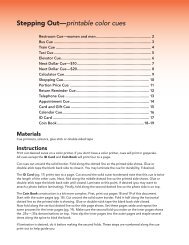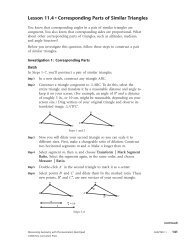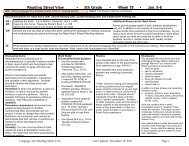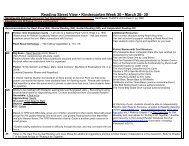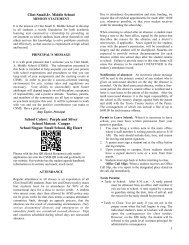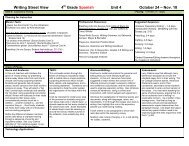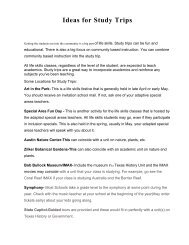Reading Street View • 3rd Grade • Week 30-34 • March 26-April 27
Reading Street View • 3rd Grade • Week 30-34 • March 26-April 27
Reading Street View • 3rd Grade • Week 30-34 • March 26-April 27
- No tags were found...
Create successful ePaper yourself
Turn your PDF publications into a flip-book with our unique Google optimized e-Paper software.
<strong>Reading</strong> <strong>Street</strong> <strong>View</strong> • 3 rd <strong>Grade</strong> • <strong>Week</strong> 35 • <strong>April</strong> <strong>30</strong> - May 4Arc Focus: Understanding Written DirectionsUnit 10: Understanding Procedural Texts and Media LiteracyText Recommendations for Read Aloud (RA), Shared <strong>Reading</strong> (SR), Guided <strong>Reading</strong> (GR), and Independent <strong>Reading</strong> (IR)RA/SR:GR:IRDo Animals Have Personalities? Treasures, Unit 5, pp. 194-196 (Directions on p. 195)Web Spinners, Treasures, Unit 5, pp. 174-175 (expository/not directions)Animal Homes, Treasures, Unit 5, pp. 178-188 (expository/not directions)Guided <strong>Reading</strong>:Amazing Bird Builders (Approaching)Amazing Bird Builders (On Level)Amazing Bird Builders (Beyond)Amazing Bird Builders (ELL)Other Texts:Scott Foresman- ScienceHow To Make a Paper AirplaneVideo: How to Make a Milk Carton BirdhousePathways Magazines (purchased for all campuses) haveprocedural text selections.Be sure to have a wide variety of fiction and nonfiction texts available to the students. Have the students write in their response journals about the similaritiesand differences in the main characters/subjects of the books they are reading.Discussing Genre:There are a limited number of texts thatinclude procedures or directions in ourstate adopted reading textbook. Youcan, however, easily integrate someScience into your instruction by usingthe procedural activities included in eachchapter.After sharing some procedural texts thatprovide instructions and directions, youcan have students write directions forsome of their favorite activities andgames. Students can share directionswith others and/or teachers can make aclass book of directions that includeseach student’s paper.Phonemic Awareness/Phonics/Word Study: Unit 6 <strong>Week</strong> 4Continue to teach word study explicitly.Objective: Decode multisyllabic words with r-controlled vowel syllablesResources: Treas. TE, pg. <strong>34</strong>9CPractice Book p.317-322, Transparency 29,Word Building Cards, Teacher's ResourceBook p.206Fluency:Research has shown that repeatedreadings are one of the most effectiveways to improve students’ fluency,especially with procedural text. Havestudents choose selections that theyhave read this week to reread withaccuracy, rate, and prosody.Vocabulary:See Robust Vocabulary inTreasures, Unit 6, pp. 199C- 199D
Building Comprehension:See Treasures, Unit 4, pp. 22-23 for ideas on explaining how to follow multi-step directions andoral directions. Have pairs of students work together to follow the instructions for one of thefollowing procedural texts in the Science textbook. (Be aware that these will need somegathering and preparation of materials.) Exploring Parts of a Plant, Scott Foresman Science pg. A6Exploring Eggs, Scott Foresman Science pg. A<strong>30</strong>Comparing How Quickly Water Moves Through Leaves, Scott Foresman Science pgs.A64-65 Experimenting with a Plant Habitat, Scott Foresman Science pgs. A77-79 Cleaning Polluted Water, Scott Foresman Science pgs. A100-101Topical Essential Questions:When do people have to read and follow directions?Why is important to follow directions?How can an author make directions clear for the reader?Then have them take turns explaining their process to other classmates. If you let each pairchoose an activity, so that the students have a variety of experiences, they will be able to“teach” their process to others who did something different.This can be extended into a discussion of how the learning process was similar in many ways,and that we have a range of skills to help us understand procedural text.Suggestions for Pre-Teaching/Applying the ELPS:Have students work with partners or take turns. One partner gives the other oraldirections on how to do a simple task, such as tie a shoe or sharpen a pencil, while theother partner follows the directions, and then restates them.When working with ELL students, always use the ELPS to guide your planning. Also use theEnglish/Spanish Cognates on the AISD website.Suggestions for Intervention:When pulling small groups, be sure to provide instruction in student’sreading gap areas. If students are having difficulty decoding multi-syllabicwords, instruction should include word study and syllable rules. If studentsare decoding but not reading fluently, instruction should include repeatedreadings of independent level texts. Provide ample time for students to readbooks on their independent and instructional reading levels.Teacher Tips: Ask students to compare characters from other stories you have read throughout the school year.. You can do this during your read loud, in guidedreading, or during an informal reading conference. Being able to describe and connect characters is an effective way to ensure good comprehension of text.Integration of Technology:Have students photograph the steps they go through as they read and follow the directions. They can then either print the pictures and add descriptive captions, or create a simpleslideshow (such as Powerpoint) or web (as in Inspiration) to illustrate their process.Technology Application 10A, 11A
<strong>Reading</strong> <strong>Street</strong> <strong>View</strong> • 3 rd <strong>Grade</strong> • <strong>Week</strong> 36 & 37 • May 7 - 18Arc Focus: Understanding MediaUnit: Understanding Procedural Texts and Media LiteracyText Recommendations for Read Aloud (RA), Shared <strong>Reading</strong> (SR), Guided <strong>Reading</strong> (GR), and Independent <strong>Reading</strong> (IR)RA/SR:GR:Share some other class websites, government websites, and nonprofit organization websites.Guided <strong>Reading</strong>:Select texts for small group instruction that are appropriate for each of your guided readinggroups. See the leveled reader data based on Connect Ed. and in the Envisions leveledreaders’ data base (access through the AISD Cloud).Additional Resources:World Wildlife WebsiteNational Geographic for KidsCreating a Classroom WebsiteMrs. Newingham’s 3 rd <strong>Grade</strong> WebsiteMrs. Rent’s 4 th <strong>Grade</strong> WebsiteMedia Literacy for Teachers and StudentsIR:Be sure to have a wide variety of fiction and nonfiction texts available to the students. Have the students write in their response journals about the similaritiesand differences in the main characters/subjects of the books they are reading.Discussing Genre:What is media literacy? Media literacy might be defined as aninformed and critical understanding of the nature of the media,the techniques used by them, and the impact of these techniques.Today’s students have grown up in the information age during averitable communications explosion. TV, movies, the Internet,magazines, newspapers, electronic books, radio, computergames, billboards, signs, and videos are all very much a part oftheir world. Because students obtain a significant amount of theirknowledge of the world from the media around them, they mustlearn how to interpret the messages that inform, entertain, orseek to persuade them. Help students explore media literacy todevelop a critical and balanced perspective of mass media andpopular culture.Building Comprehension: [See “Integration of Technology” below]Phonemic Awareness/Phonics/Word Study: Unit 6 <strong>Week</strong> 5Continue to teach word study explicitly.Objective: Decode multisyllabic words withcommon suffixes in context; Decodemultisyllabic words with derivational suffixesin contextResources: Treas. TE, pg. 385CPractice Book p. 331-335, Transparency <strong>30</strong>, Word Building Cards, Teacher's ResourceBook p. 207Fluency:Objective:Read fluently using appropriateintonation and expression.Have students do repeatedreadings of parts of their favoritebooks and poems. You may wantto consider having students selectand practice reading their favoritepoems for an end of year poetryday.Topical Essential Questions:Vocabulary:Reviewpreviouslylearnedvocabulary bydoing robustvocabularyactivities.RobustVocabularyActivities for TierII words Before reading a media text, students should determine their purpose for reading and draw on priorknowledge (recalling what they already know about the text form, author, or topic). During reading, students use comprehension strategies to make meaning from the text. After reading, students assess, critique, and reflect on what they have read. Provide opportunities for media analysis and creation that are meaningful to all students (e.g., using mediatexts that reflect students’ interests, home-life experiences, and cultural background. Guide students to evaluate the content of media texts (posters, advertisements, commercials, videos,website texts) for cultural bias Students must understand how to use current communications technologies responsibly (technologicalliteracy) and understand and make wise use of the mass media. Media literacy should also be taught in conjunction with other content areasWhere was this message placed and why?Who placed the message there and why?What impact does the message have?What consequences might it have?How effectively is the message conveyed by the sound, color,lighting, composition, and wording?How does the combination of elements increase the impact ofthe message?
Suggestions for Pre-Teaching/Applying the ELPS:Use diagrams, pictures, and manipulatives to introduce and clarify vocabulary that may be new toELLs. Provide opportunities for students to work both independently and with other students. Usemedia that reflects various cultures and customs.Suggestions for Intervention:When pulling small groups, be sure to provide instruction instudent’s reading gap areas. If students are having difficultydecoding multi-syllabic words, instruction should include word studyand syllable rules. If students are decoding but not reading fluently,instruction should include repeated readings of independent leveltexts. Provide ample time for students to read books on theirindependent and instructional reading levels.Integration of Technology:As students begin to use the internet to explore the world around them, it is important that they understand how to navigate it safely and efficiently. Learning.com provides self-guidedlessons to help them do this. It is a powerful resource and can be used effectively during reading and writing workshop.Lessons to support media literacy include: Web Browsing Basics- Basic Components/ Browsing and URLs/ Keyword Searches/ Sourcing and Ethics/ Research and Evaluation/ and Better Safe than Sorry Group Discussions (guided by Learning.com)- Safekeeping Personal Information/ Inappropriate ContentTechnology Application 4A, 4B, 5A
<strong>Reading</strong> <strong>Street</strong> <strong>View</strong> • 3 rd <strong>Grade</strong> • <strong>Week</strong> 38 & 39 • May 14 - <strong>30</strong>Arc Focus: Readers’ TheaterUnit: DramaText Recommendations for Read Aloud (RA), Shared <strong>Reading</strong> (SR), Guided <strong>Reading</strong> (GR), and Independent <strong>Reading</strong> (IR)RA/SR:GR:Plays from the Read Aloud Anthology:Take Me to Your Litter, p. 132Name That Character, p. 146Weather…whether you like it or not, p. 159The Baker’s Neighbor, p. 174The Memory Quilt, p. 184The Lion and the Ostrich Chicks, p. 199Use reader’s theater scripts and have students work in small groups to practice and preparefor a performance.Additional Resources:To teach elements of a drama, use <strong>Reading</strong> Genres Book,pages <strong>26</strong>-<strong>27</strong>Readers’ Theater Scripts and PlaysMore Readers’ Theater ScriptsIRBe sure to have a wide variety of fiction and nonfiction texts available to the students. Have the students write in their response journals about the similaritiesand differences in the main characters/subjects of the books they are reading.Discussing Genre:Readers’ Theater usually refers toenacting a text by reading roles. Thescripts (which are usually adaptations ofstories and do not necessarily start outas plays) are generally no memorizednor performed with costumes and props.The emphasis is on vocal interpretationwith fluency and prosody a focus.Usually, the parts are read byindividuals, although some roles may beread by small groups or pairs.Creating a Script for Reader’s Theatre Select an appropriate text Select characters and a narrator Decide the parts to turn into dialogueand narrative Decide if you will use any props Have the children practice reading theparts Perform for an audience! Remember to make it fun and keep itsimple!*Taken from Teaching for Comprehending and FluencyBuilding Comprehension:Introduce the readers’ theater texts to pique students’ interests by providing a brief overview ofeach script.Model the reading of some of the texts using expression and rereading (while thinking aloudabout rehearsal).Have students read text together in unison while discussing the meaning and of the storyFluency:Fluency is one of the goals for studentswhen rehearsing and performing areaders’ theater script.Students should practice more than onepart (or role) during their practice.Additional time will be spent rehearsingthe role that they will perform prior to theperformance.Vocabulary:Review previously learnedvocabulary by doing robustvocabulary activities.Robust Vocabulary Activities forTier II wordsStudent will use the punctuation to helpwith prosody and do their best to soundlike the character in the story.Topical Essential Questions:Who are the main characters?What is the main character(s) goal? What is the problem for the character(s)?What are the important events in the story?Why is the setting important to the story?How does the character try to solve his/her problem or problems?How does the character change in the story?How does the punctuation help you sound like the character?Demonstrate or reinforce any aspect of a strategic processing system by revisiting pages orsections to help students solve words, make inferences, make connections, make predictions,and analyze the text.
Sample end-of-year literacy activities:Class Books:-Class Memory Book: Students write and illustrate their favorite memories from the year.-“I Did It!” Students create books of goals and accomplishments from the school year.-Autograph Book: Students explore antique autograph book from 1800shttp://www.laurasnyctales.com/book/intro.htmlDiscuss, plan, and create a 21 st century version.-Class Yearbook: Use pictures of students to copy and create a keepsake of memories for each student about the school year.Letters: Invite students to leave behind advice for those who will follow in their footsteps in third grade or to write informative letters to the teachers who will teach themnext year.Teacher Tips: : Before cleaning up your room or taking down your bulletin boards- take pictures of all the great work you and your students have done. Print them andput them in a photo book over the summer. Next fall you’ll have great ideas and inspiration to remind you of what great things you can do for the 2011-12 school year!Integration of Technology:Learning.com provides several lessons and activities to guide students through the process of planning and creating a presentation. They can easily create a slideshow of their memoriesfrom the year, things they have learned, or a readers’ theater performance they perform.Lessons can be found in the section of Learning.com called “Presentation Basics.”Technology Application 10A, 10B, 11B



